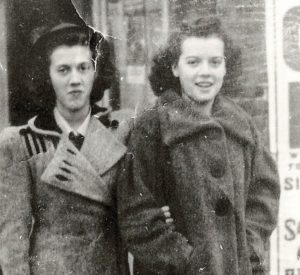Who could guess that Talitha is anything more than an ordinary skirt? Well, I could! You see, I have watched the history of this little skirt unfold in my lifetime for three generations. Talitha’s story actually began when two teenage girls, Alberta (my mother) and Omadeen were friends in a small southern Indiana town before WW2. The girls would walk arm in arm to “The Hut” to order a sandwich and dance to the jukebox. (See photo, taken in 1940.) They laughed and confided in one another, talking about boys, just like teens do today. Alberta and Omadeen later married their WW2 sweethearts, and they both stayed in touch with each other after the war when they came to live in Indianapolis with their new husbands.
Omadeen presented a little red plaid skirt she had sewn for Alberta and Walter’s first daughter, Nancy, given to her about the time she turned two, 1948. This little skirt became a treasured item when my mother decided that Nancy would get a professional photo shoot wearing the skirt. And when three more daughters followed, my mother saved the little skirt and created a memory for each daughter to have their picture also taken at age two wearing the skirt. (I am the third daughter in the first generation.)
All four pictures from the first generation were finished in soft brownish tones, called sepia, and were taken at the Holland Studio in Indianapolis. My parents proudly displayed these four photographs on top of our piano for a number of years. Visitors coming into our home would comment on the pictures and my mother would tell the story of the tradition and her friendship with Omadeen. Daddy was proud as punch of his four little girls—Nancy, Jincy, Becky, and Libby. We became the first generation to wear the little traveling skirt.
The cameras used in professional studios at this time were large and heavy. If you have purchased the book, you will notice how my talented illustrator, Courtney Smith, captured the changes with the cameras on pages 10 and 14 as compared to the camera on page six. The camera on page 10 was a 1950 Happi-Time camera which sold for $1.59. Oh, and the catchy photographer phrase, “Watch the birdie” was common at this time, as seen on the photographer’s cap on page 14.
During this time period, we owned a 1951 Chevrolet car and we lived in a two-bedroom bungalow home. (Yes, I said two bedrooms, with four daughters, a family of six!) My mother frequently wore stylish shirt-waist dresses with large clip on earrings, a black patent purse, and high heels, adding hats and gloves if it was church day. For casual wear, she wore “pedal pushers” as they were called at this time, similar to capris today. We washed our dishes by hand and our clothes were fed through a wringer on our wash machine before they were hung outside to dry. Telephones were heavy and stationary, usually black, and had long cords, sitting upon tables. Classic TV shows like I love Lucy, Gunsmoke, and Leave it to Beaver were extremely popular.
Do any of you have special family memories in this time period, 1948 to 1960?



[…] Alberta and Omadeen, friends as teenagers in Southern Indiana, 1940 public domain […]